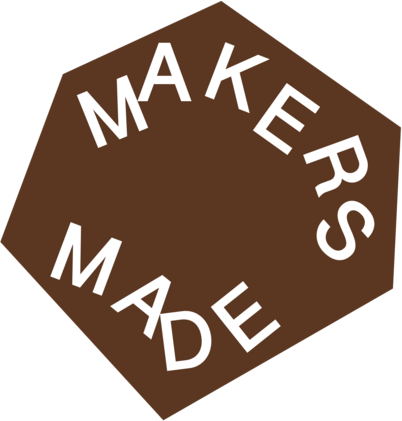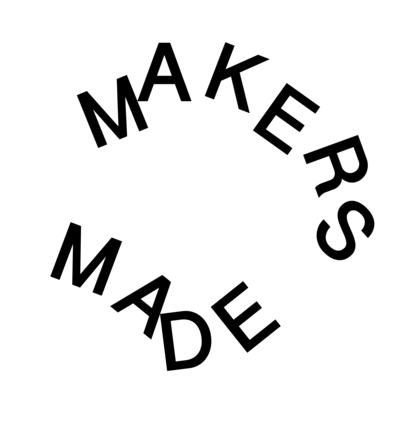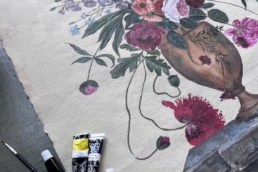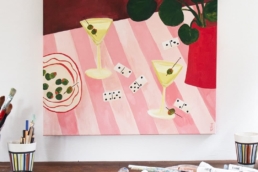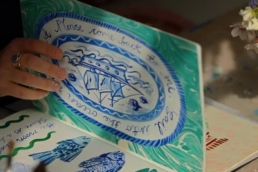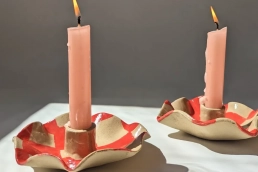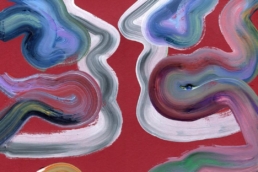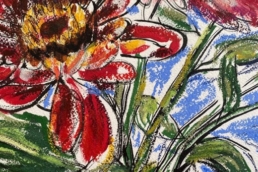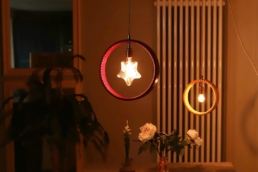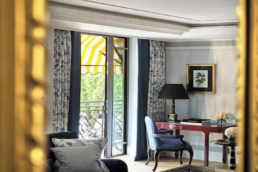Meet the Maker: The Embroidered Narratives of Lora Avedian In this Q&A, we chat with Lora about her artistic journey, her love for antique materials, and the influence of her multicultural heritage. She shares insights into her creative process, including overcoming challenges, celebrating key achievements like her residency at the Barbican, and what it means to create joyful, vibrant textile pieces inspired by nature and history.

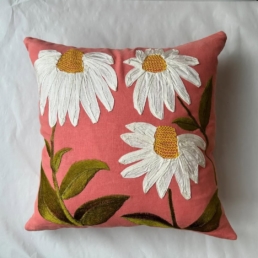
1. Can you tell us a bit about yourself and your artistic journey?
My work sits between textile design and art, encompassing everything from large-scale installations at venues like Barbican Centre and the Chelsea Flower Show to embroidered linen and soft furnishings. Which are all made by me in small batches or as exclusive collections for select retailers such as the V&A shop, and Fortnum & Mason. I studied Mixed Media textiles at the Royal College of Art and have been interested in embroidery in particular since I was a teenager. In between my BA in Embroidery at Manchester Metropolitan University and MA at the RCA I did a stint of about 7 years working for artists and designers and eventually worked as a set designer and prop stylist for still life photography. I love to create visual narratives with colour, texture and materials, which I took into my work at the RCA and has become a part of how I create my textile work.
2. What inspired you to pursue your craft? Was there a defining moment or influence that sparked your passion?
My mum got me into textiles as she had studied print design, and so I always had an appreciation and interest in textiles. When I met Karen Nicol when I was a teenager that really opened up my eyes to the possibilities of embroidery and she told me about the BA and the MA that I ended up doing, so I owe a lot of my career to meeting her.
Your craft
3. How would you describe your work in three words?
Tactile, floral, illustrative
4. What materials or techniques do you use, and why are they important to your process?
I like to use natural materials, like linens and wools to work on, and I am really keen on using second hand materials so I am always scouring the antique markets to find reels of beautiful ribbons or braids. The process of looking for these materials is something I love, the fact that they are often made in the early 20th century means they have a certain quality that it’s really hard to find now with new materials. I use these braids and ribbons to do an embroidery technique called ‘couching’ which I started using during my MA, and have developed a way of doing with my hand guided machine. It’s a key technique for me, and I even wrote a book about it!
5. Can you tell us about a favourite piece you’ve created and the story behind it?
I think my favourite piece I have made is still one from my masters, which is a large ‘cape’ which works as a wall hanging. It’s the thing I probably spent the most time and effort creative and the photographs of it still get used in articles, and I often get asked to do commissions off the back of it. It has hand embroidered tulips using braid, and three dimensional pleated carnation flowers, with 3D leaves and machine embroidered stems. I hand dyed almost every part of it, it was a real labour of love. The flowers and colour palette are symbolic of flowers and fruit of Iran and Armenian, where my father is from. It is probably the one piece of work that is most referenced by clients for projects.
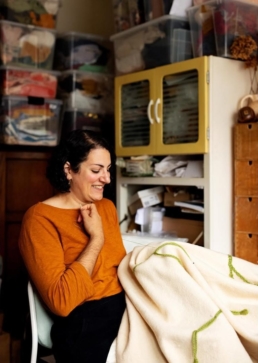
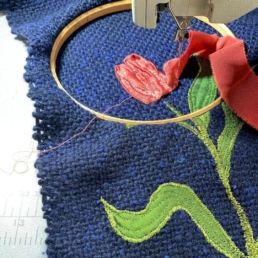
Creative process
6. What does a typical day in your studio or workshop look like?
I will get into the studio, stick the kettle on, and make myself a cup of tea. Unless I have an ongoing project I often sit and look at my mood board for a moment, and try to plan my day, writing a list is really key for me to get anything done. I will usually work for a few hours and then have my lunch at my desk. I try to go for a walk to clear my head if I have a lot going on. I usually have to leave quite early to pick up my kids so I try and make the most of my time in the studio!
7. Do you have any unique rituals or habits that help you stay creative?
I like to go to the usual galleries and exhibitions, or a National Trust house or garden. I also love to go to markets, charity shops and car boot sales. The weird and wonderful bits and pieces I can find at that sort of place can really inspire me.
8. How do you handle creative blocks? Do you have any strategies or tips for overcoming them?
Going for a walk, having a dance, doing something completely different, and listening to music!
Challenges and successes
9. What’s the biggest challenge you’ve faced as a maker, and how did you overcome it?
Not having enough space to make work is a challenge, and not knowing when to say no to projects that are out my depth. I have learnt to reach out to people for help, and it’s so often that when I speak to people about a project most things can be resolved. I think you have to make these mistakes to learn from them and get better as a business person – it’s hard to be an artist who has to do it all!
10. What’s been your proudest moment or achievement so far?
Writing a book was a great achievement. Early in my career not long after I graduated from my MA I was asked to do be artist in residence at the Barbican Shop, and with that I was asked to design the Christmas decorations for the entrance way and that was a big pinch me moment.

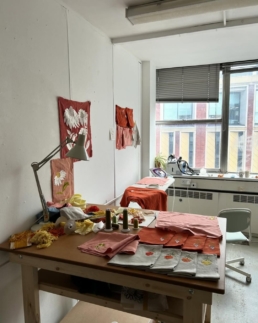
Inspiration
11. Where do you draw inspiration from for your work? What sparks your imagination and creativity?
I love going out into nature, there is just so much to be inspired by. I really enjoy going to the British museum to look at the ancient objects. The V&A is a particular favourite of mine, I don’t think I could ever get bored of it, especially the glass and ceramics rooms. I have a lot of books, and also find a lot of inspiration from antique clothing; Portobello market on a Friday is a real treat for the eyes.
12. Do you have a favourite artist, maker, movement, or tradition that has influenced your craft?
I am a big fan of the Bloomsbury Group, and their Omega Workshops project. I would say their colours and aesthetic have been really influential but there are so many people who’s work I love, it’s really hard to say! It’s always a big mix of things for me.
13. How does colour influence your practice; is it an important part of your process? Do you have a particular palette or favourites? Any go-to sources for colour inspiration?
I think colour is so important to an artist, it really helps to define your work. When I was at the RCA they had a colour room, with draws full of colour swatches, and I spent a lot of time there working on my colour palette. I referenced my visual research, and in particular a film called Colour of Pomegranates which I used a still from t get my palette. I think that really helped bring my work together in the end and I have stuck to it ever since.
Perspectives and goals
14. What role does your environment play in shaping your creativity?
I collect a lot of seemingly random and probably quite objects from car boot sales, twigs from walking in the woods, shells from going to the seaside. All of these things will feed into my work, whether it’s a colour, a texture or a shape of something. I love to be surrounded by my things, and see them on my walls, both at home and in my studio.
15. What do you want people to feel when they experience your work?
Joy! I want people to feel happy when they see the colours and textures of my work.
16. What are you currently working on, and what excites you most about it?
I am working on a new collection of embroidered artworks and interior samples coming in October 2025. Both of these things are things I have thought about for a while, and I am really excited to finally get them out of my head and into the world.


Advice and reflection
17. What advice would you give to someone starting out as a maker?
Show people your work, tell them what you do. Don’t be shy!
18. If you could go back to the start of your career, what advice would you give your younger self?
Have more confidence in your work, keep doing your research, and keep making what you like, not what you think everyone else will like.
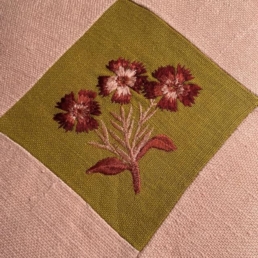
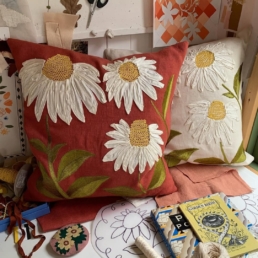
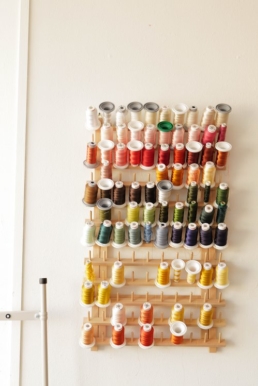
Closing thoughts
19. If you could collaborate with any artist, past or present, who would it be and why?
This is so hard! I would love to collaborate with Louise Bourgeois and make some embroidery for her, I love her use of textiles and colour.
Lora Avedian’s work seamlessly combines embroidery, storytelling, and a deep appreciation for colour and texture, creating pieces that feel contemporary yet nostalgic. From large-scale installations to delicate embroidered linens, her creations are meticulously crafted delights.
Explore Lora’s latest collections and follow her creative journey:
You can sign up to my mailing list for (infrequent but excellent) Studio News letters.
